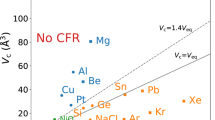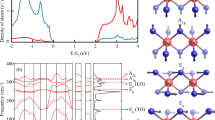Abstract
THE idea of electron and hole transport between distant sites in biological macromolecules, especially in fibrous proteins1 prompted quantum chemists to calculate the forbidden energy band gap in simple periodic protein models2–7. Conductivity measurements of several proteins under various conditions indicated a band gap or activation energy (E in the expression for the conductivity σ = σ0 exp(– E/2kT) as function of the temperature T) of the order of 3 eV (refs 8, 9), a value in agreement with the only theoretical energy band gap available at that time (ref. 2). Therefore, the intrinsic mechanism of semiconduction along hydrogen bridges seemed to be well established in 1960. Later, however, both experimentally10–13 and theoretically the question arose whether the conduction mechanism is really intrinsic. The more, refined all-valence-electron quantum chemical calculations5–7 indicated larger gaps (values in the range 6.1–16.7 eV were reported) than obtained in experiments. Most interestingly the calculation of Morokuma5 at complete-neglect-of-differential-overlap level showed that in a polyglycine chain the bandgap was not too sensitive to the changes of the chain's conformation: in conformers with appreciable H-bonding the gap found was slightly larger than in the β-sheet conformation. This latter finding pointed out the very small influence of H-bonds on the forbidden gap of periodic protein models. These semi-empirical calculation methods were designed for molecular purposes and there is still little known of their applicability to the calculation of the gap in crystals and polymers14,19. Thus we describe here use of the more reliable non-empirical (‘ab initio’) crystal orbital method15 to calculate the band gap in a most simple polypeptide model β-polyglycine.
Similar content being viewed by others
Article PDF
References
Szent-Györgyi, A. Nature 148, 157–159 (1941); Biogenergetics (Academic, New York, 1957).
Evans, M. G. & Gergely, J. Biochim. biophys. Acta 4, 188–194 (1949).
Suard, M., Berthier, G. & Pullman, B. Biochim. biophys. Acta. 52, 254–265 (1961).
Yomosa, S., Miyata, T. & Suzuki, H. J. phys. Soc. Japan 24, 878–884 (1969).
Morokuma, K. Chem. Phys. Lett. 9, 129–131 (1971).
Beveridge, D. L., Jano, I. & Ladik, J. J. Chem. Phys. 56, 4744–4751 (1972).
Suhai, S. unpublished, cited in Theoret. Chim. Acta (Berlin) 34, 157–163 (1974).
Cardew, M. H. & Eley, D. D. Discuss. Faraday Soc. 27, 115–131 (1959).
Eley, D. D. & Spivey, D. I. Trans. Faraday Soc. 56, 1432–1442 (1960).
Rosenberg, B. J. chem. Phys. 36, 816–823 (1962).
Rosenberg, B. & Postow, E. Ann. N. Y. Acad. Sci. 158, 161–190 (1969).
Miyoshi, Y. & Saito, N. J. phys. Soc. Japan 24, 1007–1019 (1968).
Henriksen, T., Sanner, T. & Pihl, A. Radiat. Res. 18, 163–176 (1963).
Bloor, D. Chem. Phys. Lett. 40, 323–325 (1976).
Del Re, G., Ladik, J. & Biczó, G. Phys. Rev. 155, 997–1003 (1967).
Hehre, W. J., Stewart, R. F. & Pople, J. A. J. chem. Phys. 51, 2657–2664 (1969).
Kertész, M. Acta Phys. Hung. 41 (1977).
Ham, J. S. & Platt, J. R. J. chem. Phys. 20, 335–336 (1952).
Duke, B. J., Eilers, J. E. & O'Leary, B. Chem. Phys. Lett. 32, 602–606 (1975).
Author information
Authors and Affiliations
Rights and permissions
About this article
Cite this article
KERTESZ, M., KOLLER, J. & AZMAN, A. Calculated forbidden band gap in periodic protein models indicating them to be insulators. Nature 266, 278 (1977). https://doi.org/10.1038/266278a0
Received:
Accepted:
Published:
Issue Date:
DOI: https://doi.org/10.1038/266278a0
This article is cited by
Comments
By submitting a comment you agree to abide by our Terms and Community Guidelines. If you find something abusive or that does not comply with our terms or guidelines please flag it as inappropriate.



